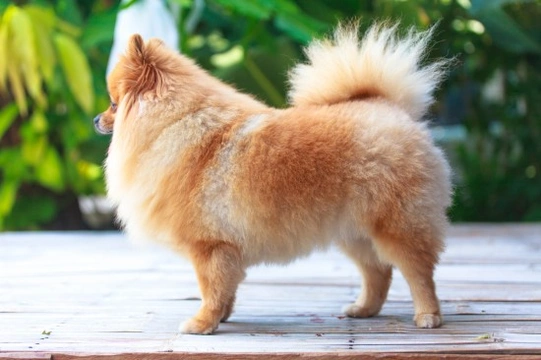Pets
Pets for studWanted petsBreedersAccessories & services
Knowledge hub
Support
Support & safety portal
Health, longevity and care of the Pomeranian dog
The Pomeranian dog, sometimes called the Pom or Pom Pom, is a small spitz breed that hails from the Pomerania region, between Poland and Germany. They are a small, toy dog breed that are closely related to some other larger working spitz dogs, including the German spitz, but that have no direct working history of their own.
The breed as a whole has been popular within Europe particularly since at least the 1800’s, when they were made fashionable as the pet of choice of royalty. Queen Victoria was one notable Pomeranian owner, who owned a particularly small example of the breed, which in itself promoted interest in ever smaller dogs being bred from Pomeranian stock.
Today, the Pomeranian dog remains very popular, both within the UK and across the world. They are excellent toy dogs and companions, and are popular with all sorts of families. However, like all purebred dog breeds, the Pomeranian has its own unique challenges in terms of genetic and hereditary health problems, which all potential owners should be aware of.
In this article, we will look at the health, longevity and general care and wellness of the Pomeranian dog in more detail. Read on to learn more.
General Pomeranian-specific care
While the Pomeranian is a dog of the spitz type, they are definitely not working dogs, and are suitable for keeping as pets and companions only! They are nice natured and very affectionate, but should not be considered to be a pushover, being bold and outgoing in temperament too!
Potential owners of the Pomeranian dog should be prepared to spend plenty of time taking care of the dog’s luxurious coat, which requires a significant amount of brushing and grooming to keep it in good condition.
Health challenges caused by the Pomeranian dog’s conformation or genetic ancestry
The inbreeding coefficient statistic for the Pomeranian dog is 5.6% on average, which is relatively low and indicates that the breed as a whole is not significantly inbred.
The coat of the Pomeranian can cause them to run into difficulty regulating their body temperatures during hot weather, and special care should be taken to ensure that the dog does not overheat, and is able to find a place to cool down. The coat will also soon become matted, knotted and tangled if not properly cared for.
Are any breed-specific health tests available for the Pomeranian?
The Kennel Club and the British Veterinary Association manage two health schemes to monitor and test Pomeranian dogs for potentially serious health and conformation problems. Potential breeding dogs should ideally be tested (if necessary) and registered within these schemes.
Elbow dysplasia scoring is the first of the two health schemes for the Pomeranian dog, and testing for syringomyelia is the second, both of which are deemed to cause problems within the breed pool as a whole. It is also possible to test Pomeranian dogs for the merle gene, which can lead to hereditary defects, but this is not currently a part of The Kennel Club and British Veterinary Association health schemes for the breed.
Health issues known to occur within the Pomeranian breed
- Elbow dysplasia, as mentioned above, is one condition that occurs within the Pomeranian breed with a reasonable degree of severity and regularity.
- Syringomyelia, which affects the spine and skull, and can be incredibly painful and untreatable.
- Patellar luxation, in which the kneecaps of the dog are not properly secured, and slip or dislocate out of place.
- Subluxation of the cervical spine, which can cause injury to the spinal cord, resulting in pain and problems with movement.
- Hydrocephalus, or water on the brain.
- Distal radial and ulna fractures, which cause severe pain to affected dogs and have a genetic element to them.
- Tracheal collapse, which leads to breathing problems and a soft, recurrent cough, due to malformation of the cartilage rings that support the trachea.
- Cataracts of the eyes, which generally occur in maturity and old age.
- Hair loss or alopecia, which may be caused due to an allergenic trigger.
- An underactive thyroid gland, or hypothyroidism.
- Cryptorchidism in male dogs, which causes either one or both testicles to fail to descend properly.
- Epilepsy, either grand mal or petit mal.
- Entropion of the eyes, which causes the eyelashes to grow inwards and scratch on the surface of the eye.
- Hyperadrenocorticism, which occurs when the body produces elevated levels of corticosteroids. This leads to problems including loss of fur, severe thirst, and excessive urination.
- Black skin disease, also referred to as alopecia X, which is a genetic condition that causes the skin of the dog to turn black and shed most of the coat. While this condition on the whole is relatively rare, the Pomeranian is one of the breeds known to suffer from it on occasion.
- Cardiac problems including murmurs and an irregular rhythm, both of which tend to progress with age, are also present within the Pomeranian dog breed pool.



